I pull at the wrapping off a newly acquired antique
book retired from the Special Service library of our
own US Air Force. A 1947, first edition Boat Building
in Your Own Backyard by Sam Rabl. I had not realized
that this first edition copy had a completely different
set of boat designs from the one I kept racking up
late charges for at the local library. A whole new
set of designs to study! Everything from flatiron
skiffs to hermaphrodite brigs was at my fingertips
for study and pondering.
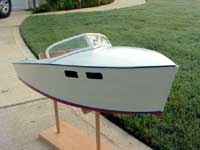 |
I had to build
a model of this little cuddy cruiser runabout
just to see how she’d be.
Click images
to enlarge |
Some of the craft were too big for my appetite (and
garage). One boat caught my eye though. This beamy,
seventeen-foot, cuddy cabin, outboard boat would fit
the bill nicely. We have a nice lake nearby with lousy
sailing wind. Sailing usually turns into bob and bake
on the lake. Powerboats rule here. A small, fun, trailer
bound, outboard boat that we could overnight on would
be just the ticket. Ok- maybe we wouldn’t sleep
on her but a sheltered place on a hot day might be
pleasant. We also have to be cheap. No varnish to
maintain and we have to use an old antique outboard
given to us. To fly around and scare folks at the
lake the design name is Buzz Bomb (apparently named
after captured rocket terror weapons used by the Axis
powers in the war that made a buzzing sound as they
flew).
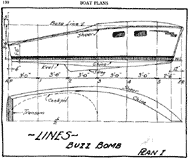 |
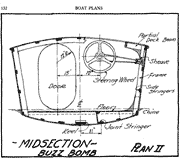
|
Let’s look at this rocket inspired craft. She
has a large open cockpit for putting out lawn chairs
and lounging after buzzing across to your cozy destination.
The cuddy cabin could hold a couple of six-foot berths
with air mattress accommodations. This is accessed
through an aircraft styled door in the cabin bulkhead.
A hatch in the top of the deck allows air circulation
and access to the bow when handling the anchor and
rode. The two windows in the sides are eighth inch
Plexiglas and non-opening. I chose a different style
windshield for the model. I favor it a little better
than the book version but my version would prove tougher
to build. The arc bottom is built in three eighths
plywood set in a slight double curvature. The bottom
is planked in three sections resting on the stringers
to get that tough bend. The side and deck planking
are one-quarter inch plywood. These are screwed and
glued to 1”x 3” oak frames and fir stringers.
She has an oak 2”x 6” keel as well.
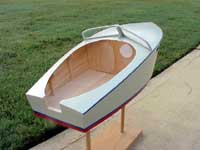 |

|
This rugged but light structure is to stand up to
a large power mill (for 1947). A twenty-five horse
‘big twin’ would work well enough but
I think our boat should do with a vintage quad as
specified. The big motors require the reinforcement
next to the keel as shown in the section view as a
‘joint stringer’. Instead of the standard
transom knee the designer specifies two steel pipe
braces running from the top of the transom and bolting
through the keel. All that’s left is to paint
her and get the camping gear loaded.
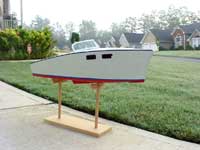 |
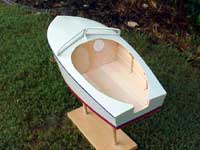
|
I had to build a model of this little cuddy cruiser
runabout just to see how she’d be. The hull
is one-sixteenth inch sheet balsa with an acetate
windshield. The boot stripe was accomplished with
self-adhesive car pinstripe. I proved to myself that
the hull could be built as he describes in the text.
I was planning furniture for the cockpit but then
thought better of it. I built the model hull just
like the real thing: upside down. The frames extend
all the way to the base line (floor) and are cut off
after the planking is completed. I love the character
of Sam’s designs and the Chesapeake flavor in
them. You can get these old books at Amazon.com at
times. I’ve got two boats to finish now but
I’ve got my eye out for the right parts to start
this one. Happy building and see ya on the water!
Ps-I’ve yet to decided whether or no I would
put the aluminum lightning bolts on the hull!
Russell Livingston

More articles about models:

|